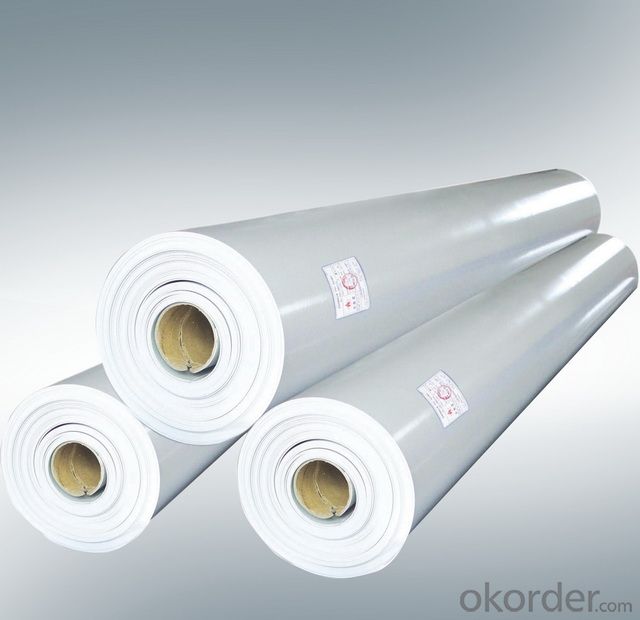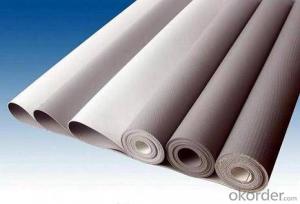PVC Waterproof Membrane Nonwoven Polyester Reinforced
- Loading Port:
- China main port
- Payment Terms:
- TT OR LC
- Min Order Qty:
- 5000 m²
- Supply Capability:
- 100000 m²/month
OKorder Service Pledge
OKorder Financial Service
You Might Also Like
1. Brief Introdustion of PVC Waterproofing Membrane:
The P series waterproofing membrane is a heat-weldable membrane produced with an integral polyester reinforcement for high strength,for use in a Magical Stone's solution system. Its excellent performance of resistance to plasticizer extraction and migration, extend the product's life and more friendly to environment.
2. Features of PVC Waterproofing Membrane
1) Excellent aging resistance. Service life of roofing material is over 20 years;
service life of underground material is over 50 years.
2) Root resistant penetration, specially used on planting roof.
3) Welding installation. Joints are solid and environment friendly, no pollution.
4) High tensile strength, good elongation and dimensional stability.
5) Good plasticity, easy and suitable for details installation.
6) Fireproof. Fire extinguished out of the ignition resource.
7) Surface is smooth, no fading and dirty resistant.
3. Specification of PVC Waterproofing Membrane
Length | 20m/roll or customized |
Width | 2.05m |
Thickness | 1.2mm; 1.5mm; 2.0mm |
Type | Homogeneous, Reinforced, Fabric back |
If Exposed | Exposed and Non-exposed |
Color | White, Grey or customized |
4. Types of PVC Waterproofing Membrane
N1—Exposed PVC waterproof membrane.
(It is mainly used as details treatment for exposed roof waterproof project)
N2—Non-exposed PVC waterproof membrane.
(It is mainly used as details treatment for non-exposed roof waterproof project)
L1—Exposed PVC waterproof membrane with fabric.
(It is mainly used for exposed roof waterproof project)
L2—Non-exposed PVC waterproof membrane with fabric.
(It is mainly used for non-exposed roof waterproof project)
W1—Exposed reinforced PVC waterproof membrane .
(It is mainly used for steel structure roof exposed waterproof project)
W2—Exposed reinforced PVC waterproof membrane .
(It is mainly used for steel structure roof non-exposed waterproof project)
5. FAQ of PVC Waterproofing Membrane
a.Can we get some samples before place order?
Answer: We can send the free samples to you by freight collect.
b.How many years can your PVC membrane guarantee?
Answer: We will guarantee the quality for 5 years at least.
c.Which countries you ever export the product?
Answer: We export the PVC membrane to South Africa, Middle east and even European countries.

- Q:Can waterproofing membranes be used on roofs?
- Roofs can indeed benefit from the application of waterproofing membranes. These membranes serve the purpose of establishing a protective barrier that thwarts water infiltration. In order to accomplish this, the membranes are carefully crafted using materials such as modified bitumen, EPDM, PVC, or TPO, all of which boast remarkable water resistance capabilities and are proficient at sealing roofs. Their usage spans across various settings, including residential and commercial environments, where they prove to be invaluable for flat roofs, low-slope roofs, and even specific sloped roof designs. Employing multiple layers of waterproofing membranes ensures optimal safeguarding against water-related harm and significantly prolongs the roof's lifespan by averting leaks and moisture accumulation.
- Q:Can a waterproofing membrane be used on gypsum block surfaces?
- Gypsum block surfaces can benefit from the use of a waterproofing membrane. These surfaces are porous and can absorb moisture, making them naturally non-waterproof. By applying a waterproofing membrane, the infiltration of water, moisture damage, and mold growth on gypsum block surfaces can be prevented. The membrane acts as a barrier, repelling water and keeping it from penetrating the material. However, it is crucial to choose a suitable waterproofing membrane that is specifically designed for use on gypsum blocks and compatible with the particular type of gypsum block being treated. Moreover, to ensure the effectiveness and durability of the waterproofing membrane, proper surface preparation and application techniques must be followed.
- Q:Can a waterproofing membrane be used for an industrial facility floor?
- Yes, a waterproofing membrane can be used for an industrial facility floor. Waterproofing membranes are commonly used in industrial settings to protect floors from water damage and to prevent moisture from seeping into the concrete or substrate. These membranes are designed to create a seamless and impermeable barrier that can withstand heavy foot traffic, industrial equipment, and chemical spills. They can also provide additional benefits such as resistance to mold and mildew growth, increased durability, and easier maintenance. However, it is important to choose a waterproofing membrane that is specifically designed for industrial applications and to follow the manufacturer's instructions for proper installation and maintenance.
- Q:Can a waterproofing membrane be used in bathrooms or showers?
- Yes, a waterproofing membrane can be used in bathrooms or showers. Waterproofing membranes are specifically designed to prevent water penetration and protect the underlying surfaces from moisture damage. They are commonly used in wet areas like bathrooms and showers to ensure long-lasting waterproofing and prevent water leakage.
- Q:Can a waterproofing membrane be used in areas with extreme weather conditions?
- Yes, a waterproofing membrane can be used in areas with extreme weather conditions. Waterproofing membranes are designed to withstand various weather conditions, including extreme heat, cold, rain, and UV exposure. They provide a protective barrier against water infiltration and can be specifically engineered to perform well in challenging climates. However, it is important to choose a high-quality membrane that is suitable for the specific weather conditions of the area.
- Q:Can a waterproofing membrane be covered or concealed by other finishes or materials?
- Yes, a waterproofing membrane can be covered or concealed by other finishes or materials. In fact, it is common practice to do so in construction projects. The purpose of a waterproofing membrane is to provide a barrier against water infiltration and protect the underlying structure. It is typically installed on surfaces such as roofs, foundations, or walls before other finishes or materials are applied. Covering the waterproofing membrane with other finishes or materials serves two main purposes. Firstly, it helps to enhance the aesthetics of the structure. Whether it is a roof, a bathroom, or a basement, concealing the waterproofing membrane allows for the installation of more visually appealing finishes like tiles, paints, or decorative elements. Secondly, covering the waterproofing membrane also provides an additional layer of protection. While the membrane itself is designed to be resistant to water, it can still be susceptible to damage from UV rays, foot traffic, or general wear and tear. By adding other finishes or materials on top, such as protective coatings, tiles, or concrete, the waterproofing membrane is shielded from potential damage, prolonging its lifespan and effectiveness. However, it is important to note that proper installation and compatibility between the waterproofing membrane and the covering materials are crucial. The covering materials should not compromise the integrity of the membrane or create any points of weakness. Additionally, any penetrations or joints in the covering materials must be meticulously sealed to maintain the waterproofing system's effectiveness. Therefore, while a waterproofing membrane can be covered or concealed by other finishes or materials, it is essential to follow manufacturer guidelines and consult with professionals to ensure that the overall waterproofing system remains intact and performs as intended.
- Q:Can a waterproofing membrane be used on both interior and exterior surfaces of a structure?
- Yes, a waterproofing membrane can be used on both interior and exterior surfaces of a structure. It is designed to create a barrier that prevents water penetration, whether it is applied on the inside or outside of a building.
- Q:Can a waterproofing membrane be used in boat decks or marinas?
- Yes, a waterproofing membrane can be used in boat decks or marinas. It is commonly used to protect the underlying structure from water damage and provide a durable, watertight barrier that helps prevent leaks and deterioration.
- Q:Is a waterproofing membrane resistant to algae or moss growth?
- Yes, a waterproofing membrane is typically resistant to algae or moss growth. Waterproofing membranes are designed to create a barrier against water infiltration, preventing moisture from seeping into the underlying structure. These membranes are typically made of materials that are not conducive to the growth of algae or moss, such as synthetic polymers or rubberized compounds. Additionally, waterproofing membranes are often treated with additives that inhibit the growth of organic matter, including algae or moss. However, it is important to note that over time, if the membrane is exposed to constant moisture or damp conditions, it may become a breeding ground for algae or moss. Therefore, regular maintenance and cleaning are important to ensure the longevity and effectiveness of the waterproofing membrane.
- Q:Can a waterproofing membrane be used on concrete slabs or foundations?
- Yes, a waterproofing membrane can be used on concrete slabs or foundations. Waterproofing membranes are commonly used in construction to prevent water penetration and protect structures from moisture damage. By applying a waterproofing membrane to a concrete slab or foundation, it creates a barrier that prevents water from seeping into the concrete and causing potential issues like cracking, water damage, or mold growth. This membrane is designed to withstand hydrostatic pressure, which is the force exerted by standing water, and it can effectively keep the area dry. It is important to select a suitable waterproofing membrane that is compatible with concrete and the specific conditions of the project. Proper installation and maintenance of the membrane are also crucial for long-term waterproofing effectiveness.
1. Manufacturer Overview |
|
|---|---|
| Location | |
| Year Established | |
| Annual Output Value | |
| Main Markets | |
| Company Certifications | |
2. Manufacturer Certificates |
|
|---|---|
| a) Certification Name | |
| Range | |
| Reference | |
| Validity Period | |
3. Manufacturer Capability |
|
|---|---|
| a)Trade Capacity | |
| Nearest Port | |
| Export Percentage | |
| No.of Employees in Trade Department | |
| Language Spoken: | |
| b)Factory Information | |
| Factory Size: | |
| No. of Production Lines | |
| Contract Manufacturing | |
| Product Price Range | |
Send your message to us
PVC Waterproof Membrane Nonwoven Polyester Reinforced
- Loading Port:
- China main port
- Payment Terms:
- TT OR LC
- Min Order Qty:
- 5000 m²
- Supply Capability:
- 100000 m²/month
OKorder Service Pledge
OKorder Financial Service
Similar products
New products
Hot products
Related keywords



























